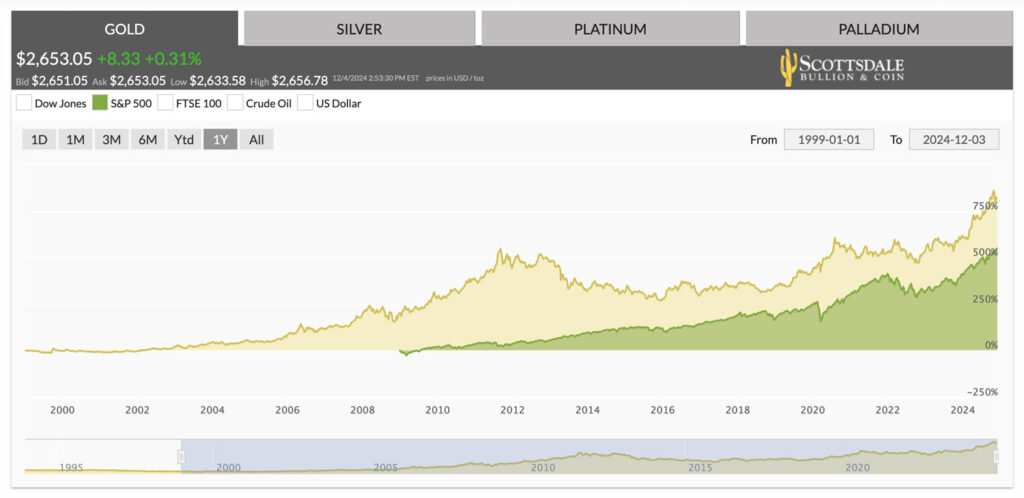Click here to get this article in PDF
Gold made headlines for outshining the broader stock market throughout 2024, but this performance is part of a larger trend, extending throughout the past three decades. In the 21st century, gold has provided a higher average return than the S&P 500, the most popular vehicle for growth among American investors.
Gold Prices vs S&P 500
In various metrics, gold has outperformed the stock market over the last 25 years. Since the start of 1999, gold has skyrocketed by 866.67%, climbing from $288.25 to a 2024 high of $2,756.76. By comparison, the S&P 500 has risen from 1,228.10 to 6,001.35 points—a gain of 388.67%. In simpler terms, a portfolio invested solely in gold would have more than doubled the returns of one invested exclusively in stocks during this period.
 While total returns provide an impressive snapshot, annualized returns offer a clearer measure of an asset’s performance over longer time frames. When looking at inflation-adjusted returns, gold boasts a 6.8% annual yield. On the other hand, the S&P 500 provided an average real return of 4.9%. Put another way, investors have gained 27.94% less from the stock market than gold in the past 25 years.
While total returns provide an impressive snapshot, annualized returns offer a clearer measure of an asset’s performance over longer time frames. When looking at inflation-adjusted returns, gold boasts a 6.8% annual yield. On the other hand, the S&P 500 provided an average real return of 4.9%. Put another way, investors have gained 27.94% less from the stock market than gold in the past 25 years.
Why Gold Outperformed Stocks
Low Bond Yields
Low bond yields have been a hidden driver of gold’s meteoric rise over the past quarter-century. US Treasury Inflation-Protected Securities (TIPS) have experienced a prolonged period of low inflation-adjusted returns, also known as real yields. Investors often flock to other safe-haven assets away from bonds in a low-yield climate. Gold has been the primary beneficiary of this shift as the opportunity cost of owning the yellow metal has been relatively low.
Stock Market Crashes
The stock market’s returns over the past 25 years have been bogged down by three cataclysmic financial crashes: the Dot-Com Crash, the Global Financial Crisis, and the COVID-19 Crash. These Black Swan events slashed the S&P 500 by 49%, 51.9%, and 34%, respectively. In response, gold has emerged as a favorite shield against inflationary pressures. Even record-setting recoveries weren’t enough to protect against the eroding public trust in fiat-based monetary systems.
Central Bank Demand
In the wake of geopolitical turmoil, particularly following Russia’s invasion of Ukraine, central banks have ramped up their gold purchases. This sustained demand has bolstered prices and reinforced gold’s reputation as an inflation hedge. Central bank gold binging set records in 2022, 2023, and the first three-quarters of 2024, with emerging markets pulling more than their weight. Experts expect this diversification trend to continue as the central bank’s shield against growing market uncertainty.
Future Gold vs Stock Market Performance
Looking at the historical gold vs stock market performance can offer insights into the potential future trajectory of these inversely related assets. Periods marked by uncertainty, volatility, and rapid change often see alternative, physical assets perform better than traditional instruments. Even after a record-shattering rally with dozens of new highs, experts are still raising their gold price predictions.
On the other hand, many warn of an overheated and inflated stock market with many companies extending into overvalued territory. Furthermore, the staggering $36 trillion debt puts additional pressure on the stock market which tends to struggle when the dollar weakens.
